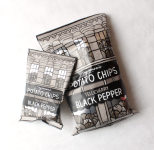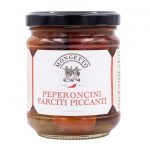Affirmative Anchovy Action
Ari on Anchovies, Part 2 of 3
![anchovy-anxiety-123U-copy-[Converted]](https://www.zingermanscommunity.com/app/uploads/2013/03/anchovy-anxiety-123U-copy-Converted.png) If you are already an anchovy lover then you’re probably pretty familiar with the concept of keeping one’s fervor for these little fish on the QT. Being into anchovies isn’t generally something one gets a whole lot of social support for. Declaring my affections usually means that I have to hear that all too familiar “Ooh, gross! I hate anchovies!”
If you are already an anchovy lover then you’re probably pretty familiar with the concept of keeping one’s fervor for these little fish on the QT. Being into anchovies isn’t generally something one gets a whole lot of social support for. Declaring my affections usually means that I have to hear that all too familiar “Ooh, gross! I hate anchovies!”
Why are so Americans so down on anchovies? The answer is actually rather simple—most Americans have never had a good one. Probably 97 percent of what people serve on pizzas and the like are downright dreadful. “Barely edible” might be overly generous; the salty, nasty, screwed up eyes and scrunched up noses happened for a reason—lousy fish, set too long in ship’s holds on the docks, then heavily salted to hide their inherent instability, just don’t taste good. Sealing up subpar stuff in stylish tins doesn’t take away the bad taste.
Without getting too political on anyone, maybe we need to initiate a bit of affirmative anchovy action. We can turn things around—there’s a whole lot more to anchovies than the standard stuff being served in subpar pizza places. It’s time, I would argue, to let go of those outdated prejudices and get to know good anchovies. To appreciate the artisan offerings, the carefully crafted offerings, made from super-fresh fish and cured almost exactly as their ancestors were a few thousand years ago. To savor the flavor of the sea, the rich, meaty, slightly salty (a good anchovy will never overwhelm with salt right off), full flavor that makes them so marvelous.
When it comes right down to it, learning to love anchovies could be one of the quickest and easiest ways there is to improve the flavor of your food. Given the choice, for life, to get as much caviar as I wanted for free, or the same offer on outstanding anchovies, there’s no question in my mind that I’d opt for the anchovies. I mean I like caviar and all. But while I can appreciate a nice ounce of Osetra on some special occasion, the reality is that I’d pretty happily eat anchovies almost every day.
Great anchovies, I’ve come to believe, could be classed as the bacon of the fish world—their small size belies their BIG flavor, and once you get to know them at their best, they too make almost everything around them better. For me, the culinary thrill is two fold:
A) Anchovies are outstanding fast food. Basically they’re ready to eat as they are when you take them out of the tin. You can add them to sandwiches, salads, sauces and pasta dishes with a minimal amount of aggravation and a maximal flavor return on your investment. A sandwich of fresh mozzarella, good anchovies and some extra virgin olive oil, with a sea salt and freshly ground black pepper on a good, thick slice of toasted country bread is pretty terrific. When the tomatoes are in season try the Catalan classic is Pa Amb Tomaquet—toast rubbed with garlic and tomato then topped with olive oil and anchovies. Add a little aged sherry vinegar and you’ll take things even higher. This time of year I skip the tomatoes and let anchovies have center stage. The same dish is superb if you sub out sherry vinegar for the amazingly delicious La Casetta vinegar from Joseph Winery in Australia.
B) Anchovies add amazing depth to the flavor of all sorts of savory sauces. In a sense, I suppose, they do for savory dishes what vanilla bean does so beautifully in baked goods—round out already good flavors and take everything else up a notch. Almost any cooked tomato dish (especially if you’re using canned ones in winter) with anchovies added will be excellent. So are salad dressings, soups, fish dishes, rice casseroles, and many pasta sauces. All can benefit greatly from the seemingly innocent addition of a couple of good anchovies. The most amazing thing is that when you use them this way hardly anyone will ever be able to identify that there are anchovies in there in the first place. Add an anchovy or two as you sauté your vegetables early on in the cooking process and within minutes the evidence—I mean the anchovy—will have vanished, literally melting its mellow way right into the sauce. Whether you tell your guests or not is up to you. Tamar Adler’s book has a very simple recipe for an all-about-anchovies salsa verde—a smooth, pesto-like sauce of chopped fresh parsley, garlic, olive oil and anchovies—to put onto boiled beef.
This culinary allegiance to the anchovy is hardly a new one. A couple thousand years ago great Roman cooks were already using enormous amounts of anchovies. They (the fish, not the Romans) were the essential ingredient in a sauce known as “garum.” According to Reay Tannahill in Food in History, it was, “. . . a clear, golden fermented fish sauce with a distinctively salty flavor.” Today the sauce is extinct—amazingly there are no recognized written recipes for it. A few years back, after a trip I took to Italy’s Amalfi Coast, I came across a source for a modern version of this superb, savory, salty, super quick to use anchovy essence called Garam Colatura. It is, as I write, on the shelves at the Zingerman’s Deli and at Zingerman’s Mail Order. Supplies are often limited but its flavor is almost infinite—a few drops do delicious things to your cooking.




Zingerman’s Art for Sale